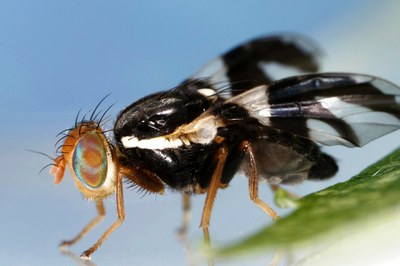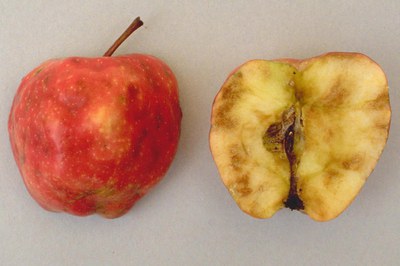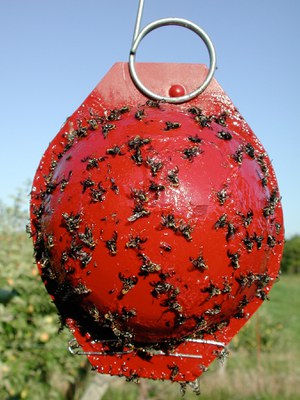Documents
It's Apple Picking Time!
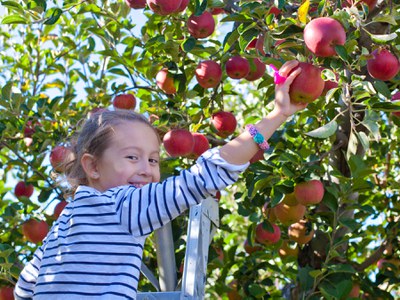 |
| This is a great time of the year! |
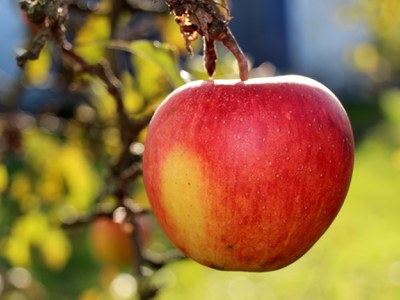 |
|
The background color of the apple skin will turn from green to yellow when the |
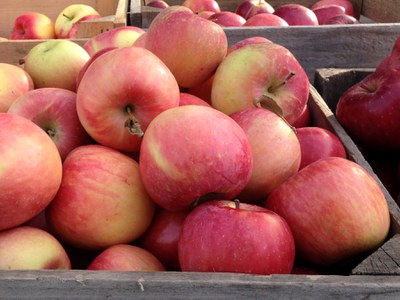 |
|
Store apples in a cool, humid and dark place. |
The sun is shining, the air is crisp and cool, and our apple trees are loaded with fruit. It’s a great time of the year!
Many cultivars are ready to be picked now. If you are not sure, an apple is ready for picking when its background skin color turns from green to yellow (middle photo). The fruit comes off easily when harvested.
Use an upward and twisting motion when harvesting fruit. Do not yank down on branches. This can tear off the knobby, branch spurs (shown near the fruit stem in middle photo), where next year’s fruits will come.
Apples on trees can tolerate temps approaching 26°F before frost damage occurs. If they freeze on the tree, wait for the fruits to thaw before harvesting. Frozen fruits should be used promptly.
Store fruits in a cool (34–40°F), humid (90% RH), dark place. A refrigerator is best, but a root cellar or unheated garage is acceptable.
A complete list of recommended apple cultivars for North Dakota is available.
Written by Tom Kalb, Extension Horticulturist, North Dakota State University. Photos courtesy of camknows, Michael E. and U.S. Department of Agriculture.
Raspberries for North Dakota
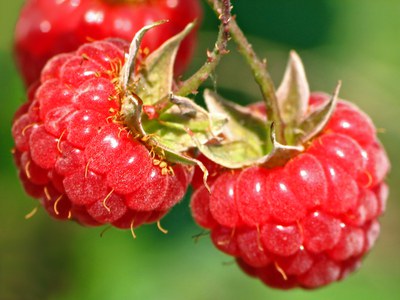
Raspberry is a popular fruit that is easy to grow in North Dakota. Plant both summer- and fall-bearing types to extend your harvest.
Summer-bearing types are most popular. They bear fruit on second-year canes, which are pruned out after harvest.
Fall-bearing types bear fruit on their first-year canes. Select early-ripening fall-bearing cultivars only. You can mow the canes in April for a strong fall crop or allow the canes to develop and bear fruit during the summer.
Raspberries are established to grow in hedgerows or hills. If hedgerows, set canes 2 feet apart in rows spaced 6 to 8 feet apart. Prune every winter to thin canes to stand 3 to 4 inches apart. If hills, set hills 4 to 6 feet apart in each direction. Prune in the winter to allow six to eight canes per hill.
Purple raspberry canes are pinched when 30 inches tall to encourage lateral branches and these lateral branches are trimmed back to 18 inches long in the winter.
Trellising will make plantings easier to manage, especially the more vigorous purple types.
Spotted wing drosophila has emerged as a major pest of raspberries.
The following cultivars are hardy to Zone 3 unless noted otherwise:
|
CULTIVAR |
DESCRIPTION |
|
Prelude |
Earliest raspberry. Good-quality fruits. Also bears a few berries in fall. Zone 4 only. |
|
Boyne |
Productive and very winter hardy. Medium-sweet berries good for freezing and desserts. Ripens in mid-July. From Manitoba. |
|
Killarney |
Large, bright red fruit. Excellent flavor and aroma. Good yields. Sturdy canes. |
|
Latham |
The standard red raspberry. Very reliable producer of bright red fruits. Good quality. Very hardy. |
|
Nova |
Good yields of firm, bright red fruits. Canes are vigorous, upright, and nearly thornless. Heat tolerant. From Nova Scotia. |
|
Jewel |
Hardiest black raspberry. Tall, productive, vigorous canes produce shiny black fruit. Good flavor. Trellising is suggested. From New York. Zone 4 only. |
|
Encore |
Late-season summer raspberry. Large, cohesive fruits with good flavor. Sturdy, upright canes are almost thornless. Zone 4 only. |
|
Royalty |
Thorny canes produce excellent yields of large, purple berries in late summer. Excellent for freezing and jams. Use trellis. Zone 4 only. From New York. |
|
Polana |
Earliest fall-bearing type. Canes are very hardy and produce impressive yields of glossy red berries. Ripens in August. From Poland. |
|
Autumn Britten |
Improved fall-bearing type. Good yields of firm, large berries. Bright red. Good flavor. Canes are vigorous with few spines. Ripens in early September. Zone 4 only. |
|
Anne |
Large, flavorful yellow raspberry. Large, pale yellow berries ripen late in fall. Very sweet. Zone 4 only. |
Source: Tom Kalb and Kathy Wiederholt of North Dakota State University Extension; Charles Elhard and Jamie Good of North Dakota Department of Agriculture. Reviewed 2019. Starting a Community Orchard in North Dakota. Photo courtesy of Marko Kivela.
Crabapple Fruits for North Dakota
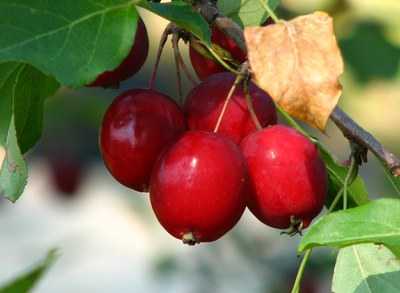
The tart flavor of crabapple makes it popular for canning and in making jellies. This fruit is grown just like apples.
A crabapple will pollinate an apple tree and vice versa. Most crabapples are partially self-fruitful but will produce higher yields in the presence of another apple or crabapple cultivar. These following cultivars are hardy to Zone 3 and are listed in order of ripening:
|
CULTIVAR |
DESCRIPTION |
|
Dolgo |
Russian variety popular for its bright white flowers and brilliant red fruits. The 1-inch fruits make good jelly. Tree resists scab and fire blight. Fruit ripens in late August. |
|
Centennial |
A progeny of ‘Dolgo’ and ‘Wealthy’. Large (1.75 to 2 inches) fruit is one of the best for fresh eating. Red blush over orange skin. Short storage life. |
|
Whitney |
Large, yellow fruits with red stripes. The juicy, slightly yellow flesh is good for preserving and pickling. |
|
Chestnut |
Prized for its mildly tart, nut-like flavor. Fruits have a reddish-bronze skin and average more than 2 inches in diameter. The yellowish flesh is good for fresh use and desserts. Ripens in mid to late September. |
Source: Tom Kalb and Kathy Wiederholt of North Dakota State University Extension; Charles Elhard and Jamie Good of North Dakota Department of Agriculture. Reviewed 2019. Starting a Community Orchard in North Dakota. Photo courtesy of Larry Krause.
Apricots for North Dakota
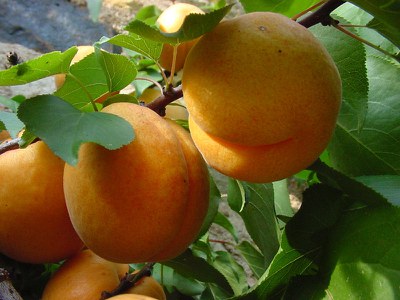
Apricots are loved for their delicate blossoms in spring and their golden fruits in summer.
Apricot trees bloom very early so keep them out of frost pockets and plant them in a protected site.
We want to delay the blooming as much as possible. A north- or east-facing location will be slower to warm up compared to a south- or west-facing location.
Apply wood mulch under the trees to keep the soil insulated. This will delay the soil from prematurely warming up in spring and delay the opening of flower buds.
The following cultivars are naturally dwarf and can be planted 10 to 15 feet apart.
The Canadian cultivars are self-fruitful but produce better yields when more than one cultivar is planted. They are hardy to Zone 3.
The Minnesota cultivars ‘Moongold’ and ‘Sungold’ should be planted together and are hardy to Zone 4.
The following cultivars are listed in order of ripening:
|
CULTIVAR |
DESCRIPTION |
|
Moongold |
Large, light orange fruits. Sweet, sprightly flavor. Good quality. Blooms in late April and ripens in late July. Use ‘Sungold’ as pollinator. From Minnesota. Zone 4. |
|
Debbie's Gold |
Yellowish-orange fruit with firm texture and less sweet flavor. Freestone. For canning and fresh eating. From Alberta. |
|
Scout |
Gold fruit blushed with red. Flesh is tender, sweet and juicy. Freestone type. Good for desserts, canning and drying. Blooms in early May. From Manitoba. |
|
Westcot |
Large, freestone fruits. Mild, sweet flavor. From Manitoba. |
|
Brookcot |
Yellowish-orange with a red blush. Flesh is juicy with good flavor for fresh eating or canning. Semi-freestone type. From Alberta. |
|
Sungold |
Golden fruits with orange flesh. Freestone. Sweet, mild flavor. Blooms in late April and ripens in August. Use ‘Moongold’ as pollinator. From Minnesota. Zone 4. |
Source: Tom Kalb and Kathy Wiederholt of North Dakota State University Extension; Charles Elhard and Jamie Good of North Dakota Department of Agriculture. Reviewed 2019. Starting a Community Orchard in North Dakota. Photo courtesy of Max Westby.
Apples for North Dakota
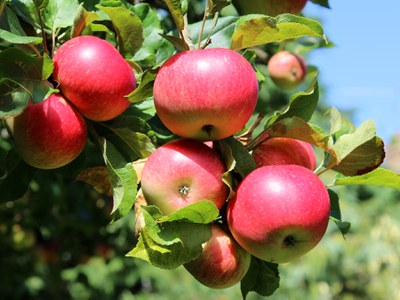
When it comes to planting trees, there is an old proverb that goes: “Today is the second best day to plant a tree. The best day was yesterday!”
Don’t keep waiting. Apple is the #1 fruit grown by gardeners in North Dakota. Most apples in North Dakota take five or more years before they produce decent crops. That’s a long time!
Pick a sunny site that has good drainage and is sheltered from strong winds. Keep out of frost pockets.
An apple cultivar will reject its own pollen. Make sure there is another apple or crabapple cultivar within 100 feet if possible.
Look for cultivars that are hardy, mature early and produce high-quality fruit. The earliest cultivars are generally good for fresh eating but do not store well. Later-ripening varieties store better, but they run the risk of never maturing before the snow flies.
Apple growers in Zone 4 should strongly consider a tree with a dwarfing rootstock, especially if snow cover is present during the winter. Trees with dwarfing rootstocks are easier to manage, bear earlier and are more productive. Staking is generally recommended to prevent dwarf trees from breaking at their graft unions.
Look for the hardiest rootstock available. Among the hardiest are Ottawa 3 and Bud 9, but these are not as commonly available as others. G30 from Cornell University is hardy and resists fire blight.
The introductions from Malling are most common in the marketplace, and M26 is the hardiest of this group. M7 has been widely planted in Midwest orchards for decades; it produces a freestanding tree. These rootstocks will create trees about 12 to 16 feet tall under normal growing conditions.
Dwarfing rootstocks are not hardy in Zone 3. These gardeners should grow “standard” trees with rootstocks of ‘Dolgo’ or ‘Antonovka’, and then prune aggressively to keep the trees 16 feet or lower in height.
The following are some of the best cultivars for North Dakota, listed in order of ripening. All are hardy in Zone 3 unless noted otherwise:
|
CULTIVAR |
DESCRIPTION |
|
Dakota Gold |
Large, yellow apple. Good for fresh eating, sauce and pies. Very hardy. Annual bearer. Tolerates fire blight. Ripens in late August. From North Dakota. |
|
Norkent |
Orangish fruit with apple-pear taste similar to ‘Golden Delicious’. From Canada. |
|
State Fair |
‘Mantet’ x ‘Oriole’. Bright red apple with crisp, juicy white flesh. Fresh eating. From Minnesota. |
|
Zestar! |
Excellent early apple. Crisper and better storage life than other early apples. Striped red skin. Marginally hardy in Zone 3. From Minnesota. |
|
Hazen |
Large, dark red fruit. ‘Duchess’ × ‘Starking Delicious’ parentage. Natural semi-dwarf (10 to 15 foot) tree. Does well without spraying. Mild flavor for fresh eating and cooking. Short storage life. From North Dakota. |
|
Duchess |
Popular apple from Russia. Medium to large size; mildly tart taste good for pies and sauce. Shows resistance to scab, rust, and fire blight. Ripens in early September. |
|
Wealthy |
Striped red apple with tart flavor. Precocious bearer. Ripens mid-September. Stores well. Heirloom from Minnesota. |
|
Goodland |
Medium-large apple; creamy yellow with blush of red. Ripens in late September and stores well. Flesh is crisp, juicy and aromatic. For fresh eating and especially good in pies. From Manitoba. |
|
Red Baron |
Medium-sized apple. Productive tree bears at a young age and tolerates fire blight. From Minnesota. |
|
Northern Lights |
Red with striped color pattern. ‘Haralson’ × ‘McIntosh’ parentage. Excellent, slightly tart flavor good for eating and cooking. Short storage life. From North Dakota. |
|
Prairie Magic |
Yellow with red blush. ‘Goodland’ x Mantet’ parentage. Medium-large fruit is sweet and crisp. Vigorous tree. From Manitoba. |
|
Wolf River |
Very large apple. Yellow with red stripes. Used for cooking. Zone 4 only. |
|
Sweet Sixteen |
Medium-size, red apple with spicy-sweet, crisp, aromatic taste. Creamy yellow flesh. Good for fresh eating. Takes a long time to bear fruit after planting. |
|
Honeycrisp |
Most popular apple in Midwest. Sweet and balanced taste; very crisp texture. Exceptional for fresh eating. Large fruits ripen in late September to early October and store very well. Marginally hardy in Zone 3. From Minnesota. |
|
SnowSweet |
Bright white flesh that resists browning when sliced. Ideal for snacks. Shows some resistance to scab and fire blight. Zone 4. |
|
Haralson |
The standard for cooking apples in the Upper Midwest. Pleasantly tart flavor. Some resistance to fire blight. Easy to grow and stores well. From Minnesota. |
|
Wodarz |
Popular heirloom in North Dakota. Green, knobby “ugly” apple is very sweet and stores well. Shows some tolerance to fire blight. Late. |
Source: Tom Kalb and Kathy Wiederholt of North Dakota State University Extension; Charles Elhard and Jamie Good of North Dakota Department of Agriculture. Reviewed 2019. Starting a Community Orchard in North Dakota. Photo courtesy of DataHamster.
Cherry Plums for North Dakota
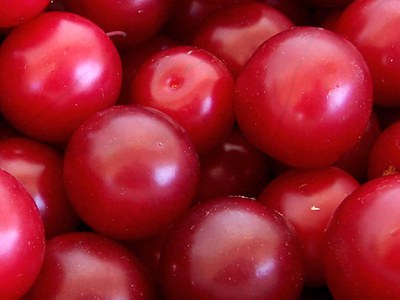
Cherry plums were developed to survive the extreme weather of the northern Great Plains. They are extremely hardy (Zone 3), resist drought, and will bear fruit after one to two years. They grow as small trees 6 to 8 feet tall and can be spaced 4 to 8 feet apart.
They are self-unfruitful. Plant at least two cultivars for fruit set. The fruit is not as big or as delicious as most other plums. Fruits begin to ripen in late August.
The following cultivars are listed in order of ripening:
|
CULTIVAR |
DESCRIPTION |
|
Red Diamond |
Dark red skin and flesh. Sweet and juicy. |
|
Sapalta |
Dull purple skin and flesh. Nearly freestone. Very productive. |
|
Compass |
Dark purple fruit with yellow flesh. Juicy flesh with sour skin. Good for jams and sauces. |
Source: Tom Kalb and Kathy Wiederholt of North Dakota State University Extension; Charles Elhard and Jamie Good of North Dakota Department of Agriculture. Reviewed 2019. Starting a Community Orchard in North Dakota. Photo courtesy of Fir0002.
Pears for North Dakota
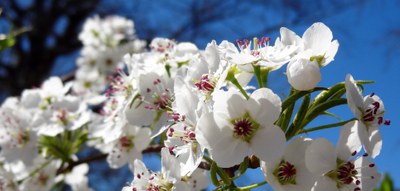 |
| Pear blossoms. |
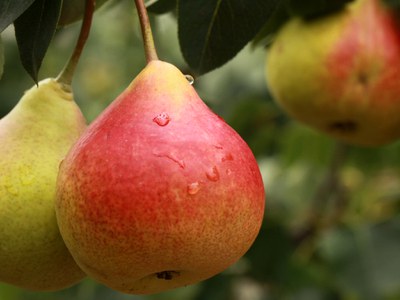 |
| Ripening fruit. |
Pears are one of the most delectable fruits you can grow in your backyard. The fruits are great for fresh eating and canning. A spectacular bonus of growing pears is the display of pure white blossoms in springtime. It is absolutely stunning!
The keys to success for growing pears in our state include proper site selection, selecting hardy cultivars, training the branches to avoid upright growth, and monitoring for fire blight.
Pear blossoms are sensitive to frost injury. Avoid planting the trees in frost pockets. Mulching with wood mulch can help to insulate the soil, leading to a slow, gradual warming and preventing premature bud break.
The branches of pear trees often have an upright habit. Annual pruning/training and the use of branch spreaders can maintain more horizontal, stronger, more fruitful branches.
Fire blight is the leading killer of pears. This bacterial disease is introduced into the tree through wounds; often created by hailstorms or improper pruning. The initial symptoms will be scorched branch tips. Keep your eyes open for this disease and prune it out when you see it. The “ugly stub” treatment is often used for removing fire blight-infected branches.
Pears are best harvested before they are mature but not yet fully ripe. Mature pears are firm and will easily come off the branch when they are twisted upwards. Harvested pears will ripen fully off the tree when stored during a week of temperatures in the 60s.
The species of pears you select is important. Many of us are familiar with the ‘Bartlett’ pear (Pyrus communis). These varieties with relatively large, teardrop-shaped fruits will not be hardy in the northern part of our state. Ussurian pears (Pyrus ussuriensis), which include ‘Ure’ and ‘Golden Spice’ are hardier. Asian pears (Pyrus pyrifolia) are not hardy in North Dakota.
The varieties listed below are hardy only in Zone 4 unless noted otherwise. They are listed in order of ripening. Two compatible varieties are needed for good yields.
| CULTIVAR | FEATURES |
| Early Gold | A seedling of 'Ure' displaying superior vigor and earliness. Matures in early to mid-August. Hardy in Zone 3. Use 'Ure' as pollinator |
| Golden Spice | Small fruits have a tart, spicy flavor. Good for canning. Vigorous trees are very hardy (Zone 3). Excellent choice as a pollinator. From Minnesota. |
| Ure | Small, greenish-yellow fruit. Very juicy and sweet. Hardy to Zone 3. From Manitoba. |
| Summercrisp | Fruits should be eaten green when they have a crisp texture like an Asian pear. Ripe fruit is sweet. Some resistance to fire blight. Pollinate with 'Parker'. From Minnesota. |
| Parker | Seedling of a Manchurian pear. Large, bronze fruit with good eating quality. Fine grained, tender and juicy flesh. From Minnesota. |
| Luscious | Medium to small, bright yellow fruits. Dessert quality. Tree resists fire blight. Cannot pollinate other varieties. Pollinate with 'Parker'. From South Dakota. |
Information from:
Kalb, T., K. Wiederholt, C. Elhard and J. Good. Starting a Community Orchard in North Dakota. 2019 (revised). NDSU Extension Publication H1558. p. 16.
Contributing source:
Smith, B.R. and T. Roper. 2005. Home Fruit Cultivars for Northern Wisconsin. University of Wisconsin-Extension.
Photos courtesy of Martin LaBar and rkrl001 from Pixabay.
Wormfree Apples
The #1 apple pest is emerging now. Maggot flies are searching for apples to lay their eggs into. These eggs will hatch into tiny maggots that create tunnels inside fruits.
Should you spray your tree to protect the apples? Maybe, but only if the flies are there.
Monitor for the presence of maggot flies by hanging traps in the trees. These traps are red spheres coated with Tanglefoot, a sticky glue (see photo below). The flies are attracted to the red spheres, thinking they are a ripe apple to lay eggs inside—but then they get stuck.
These traps are available online and at major garden centers. Different models are available, including traps that come with sticky yellow boards and apple-scented lures.
You can make your own traps out of wooden balls (3 or more inches in diameter), painted red, with an eye screw and wire hook. Ripe apples from the store can be hung in the tree using clothes hangers. Coat the traps with Tanglefoot.
Hang 1–2 traps in small trees; 5 or more in large trees. Place traps facing a brushy area and/or on the south side of the tree.
The apple maggot fly is ¼-inch-long (slightly smaller than a housefly), with dark markings on its wings and a white spot where the thorax meets the striped abdomen.
If you find maggot flies in your traps, you should consider spraying the crop. Recommended pesticides include carbaryl, esfenvalerate or phosmet. Organic growers may consider spinosad. Continue spraying as long as maggot flies appear.
Written by Tom Kalb, Extension Horticulturist, North Dakota State University.
Source: MacKenzie, J. J. Hahn, and M. Grabowski. 2011. Pest management for the home apple orchard. University of Minnesota: Twin Cities.
Photos courtesy of Joseph Berger, Bugwood.org; H.J. Larsen, Bugwood.org; and The Jentsch Lab of Cornell University.
Worm-free Apples
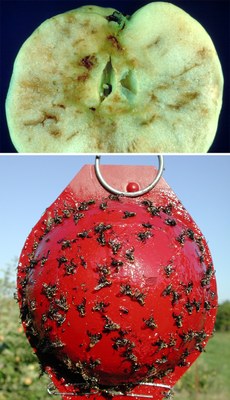
- Apple maggots create tunnels in fruits. Traps may be used to monitor for the presence of the egg-laying flies.
Nobody likes wormy apples … but nobody enjoys spraying pesticides. What’s the solution?
Spray only when needed.
The apple maggot is the #1 pest of apples in North Dakota. The egg-laying flies begin attacking our fruits in early July. Now is the time to set up traps to monitor for the flies.
Apple maggot traps are available at major garden centers and online. These plastic spheres are coated with the sticky substance Tanglefoot and hung in trees. The flies are attracted to the red spheres and will get stuck when they land on them.
You can make your own 3-inch-diameter spheres out of wood and hang them using an eye screw and wire hook. Another option is to use bright red apples, skewer them with a thick wire (or coat hanger) and hang them up. Coat them with Tanglefoot.
Small trees need a couple traps and full-sized trees can use five traps. Hang them on outer branches, placing at least one on the south side and on branches facing brushy areas.
Check every week. If you don’t see any flies, you don’t need to spray.
If you do see flies, you have a choice to make: Spray to protect your fruits or get ready to make a lot of maggot-rich applesauce this fall.
Written by Tom Kalb, Extension Horticulturist, North Dakota State University.
Source: University of Minnesota. Apple maggot. www.extension.umn.edu/garden/yard-garden/fruit/ apple-pest-management/maggot/. Photos were made available under Creative Commons licenses specified by the photographers: E.H. Glass, New York State Agricultural Experiment Station, Bugwood.org; Cornell University, blogs.cornell.edu/ jentsch/scouting-reports/.
Rejuvenate Your Old Apple Tree
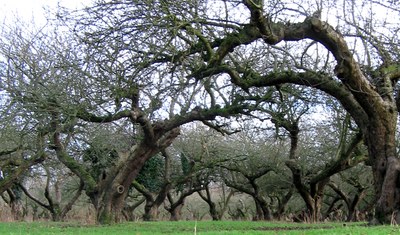
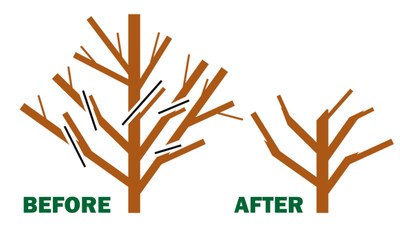
Do you have an old apple tree in the backyard? Now is a great time to rejuvenate it!
PRUNE NOW. Late winter is the best time to prune for several reasons: First, the tree is dormant and will suffer less shock.
Second, pruning in late winter minimizes the exposure of wounded tissues to the ravages of winter.
Third, diseases are less active in winter and you are less likely to spread diseases on your pruning tools. Wound dressings are not needed when pruning in the dormant season.
REDUCE HEIGHT. This will make the tree easier to manage and the apples easier to harvest. Old trees can be pruned into an umbrella shape, with branches cascading in all directions from the main trunk, not allowing tree height to exceed about 12 feet (see the photo of an old orchard at top right).
DEVELOP A STRONG FRAMEWORK. The most vigorous branches will have glossy bark (not old, scaly bark).
Trim just above these vigorous, sturdy branches. This will bring the tree down to size (see the BEFORE/AFTER figure at right).
We want to keep sturdy, productive branches. these will have an angle of 60-degrees from the trunk. To say it another way, using the face of a clock as our guide, the strongest, most productive branches will be at angles of 2 and 10 o’clock.
Remove vertical and horizontal branches. Vertical branches are not fruitful and their narrow crotches are weak. Horizontal branches struggle to support a heavy fruit load.
REMOVE CLUTTER. We want to get more sunlight and air movement in the tree. This will improve fruit color and reduce humidity that promotes diseases in the canopy.
Start by removing the water sprouts. These are vertical, pencil-thick shoots. Water sprouts are unproductive and clutter up the canopy.
Remove broken branches, branches that rub one another, and inward facing branches.
BE PATIENT. To avoid sunscald damage and shocking the tree, avoid removing more than 25 percent of the tree’s wood at any one time. It’s best to give yourself at least two years to rejuvenate the tree.
BE REALISTIC. Apple trees age like people do. We can live 100 years, but we reach our prime at around 25 years. Pruning an old tree will lead to higher yields and much better quality fruit, but your tree is still old. It’s nice to have a tree with character and charm in the backyard, but it doesn’t hurt to have a young and productive tree nearby. Spring is the best season for planting.
Written by Tom Kalb, Extension Horticulturist, North Dakota State University. Photo courtesy of Mark Shirley.





